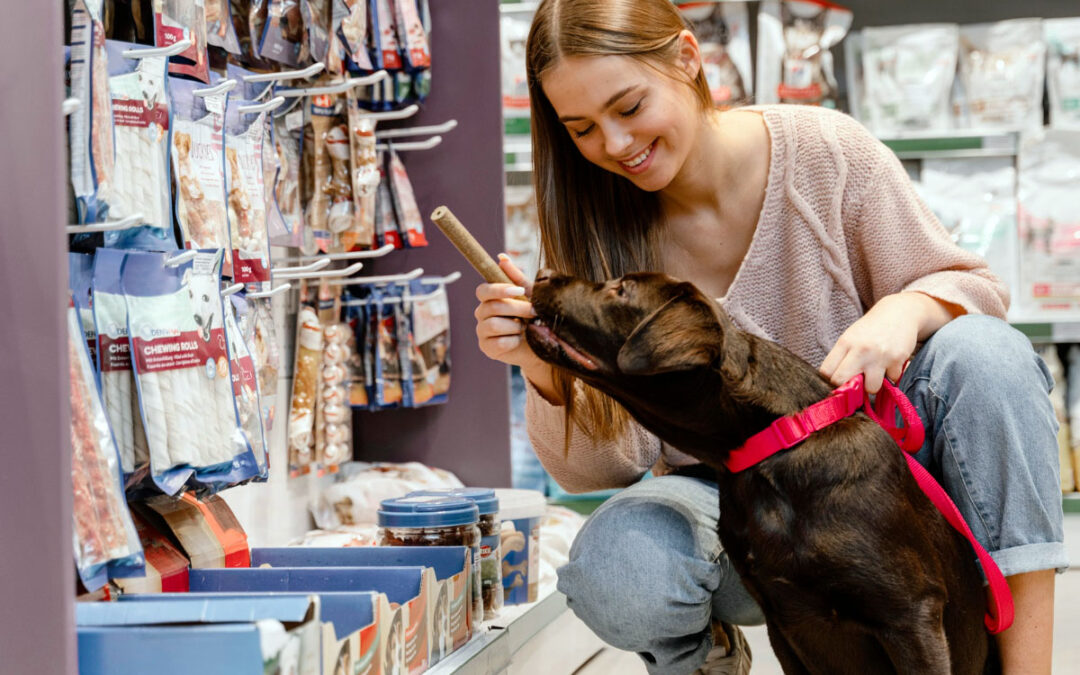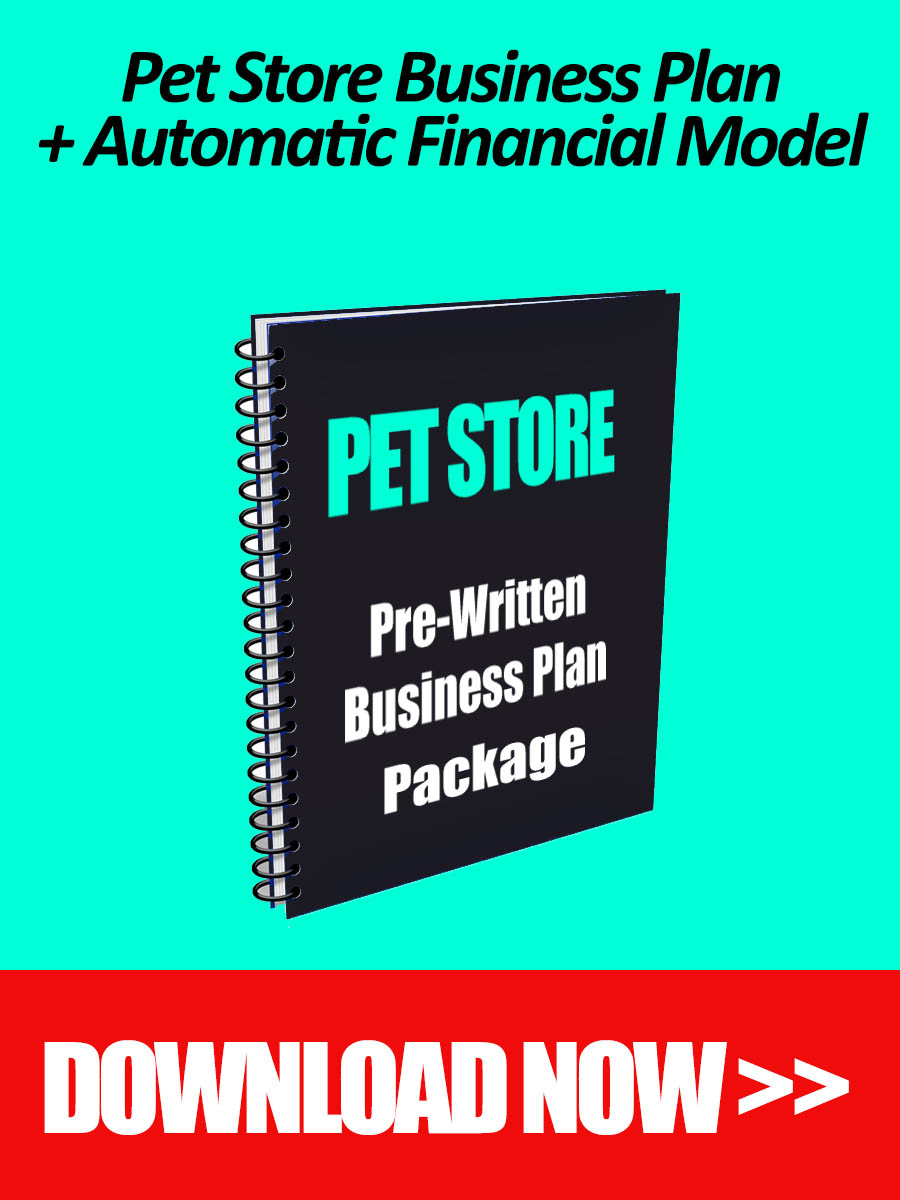Are you starting a new pet store or looking to expand an existing one? Whatever the case, a detailed financial plan can provide the roadmap for achieving your business goals while ensuring a better visibility and understanding of your project.
I have been helping pet shop owners build robust pet store business plans and detailed financial forecasts for over fifteen years and my purpose in this guide is to share with you crucial tips and advice you can use in your own financial planning process.
In this article, we will explore the key elements involved in developing a comprehensive financial plan for a pet store. We will delve into the intricacies of forecasting costs and capital expenditures (Capex), estimating revenue streams and constructing key financial statements that investors care about.
By understanding these components and their interrelationships, you will be equipped with the necessary tools to formulate a robust financial strategy tailored to the specific needs of your pet store project.
It is important to recognize that a financial plan is not a static document but a dynamic tool that should be regularly reviewed and adjusted as your business evolves. With a well-designed financial plan in place, you will be better positioned to make informed decisions, identify potential risks and opportunities, secure financing, and ultimately steer your pet store toward long-term success.
Pet Store Financial Plan Template in Excel
Before we start, I suggest you have a look at our ready-made pet store business plan package. It includes a pre-written business plan text in Word and an automatic financial spreadsheet in Excel tailored to the pet retail industry which you can easily customize, no accounting or financial expertise needed.
Now, let’s dive into the first key step of building a financial plan for a pet store: forecasting your costs.
Pet Store Financial Plan: Forecasting Costs
The first step here is to understand the operating costs involved in running a pet store business.
Operating Costs
Operating costs encompass the day-to-day expenses required to keep your pet store running smoothly. These typically include:
- Rent or Lease: The cost of renting or leasing a suitable space for your pet store is a significant expense. Research the local market to determine prevailing rental rates and factor in potential annual increases. Don’t forget to include brokerage fees and other expenses such as deposits and other admin fees if applicable.
- Utilities: Consider expenses such as electricity, water, heating and cooling. These costs can vary based on the size of your pet store and its location.
- Inventory: As a pet store owner, you’ll need to stock a wide range of products, including pet food, supplies, toys, grooming products, and more. Forecast your inventory needs and estimate the associated costs based on market prices and expected demand.
- Salaries and Wages: Determine the number of employees you’ll need to hire, their roles, and their corresponding salaries or hourly wages. Account for additional costs such as payroll taxes, benefits, and bonuses. Let’s also remember that salaries are usually expected to increase every year so make sure to include this raise in your financial plan.
- Marketing and Advertising: No pet store can succeed without proper marketing. This is why it is very important to allocate a budget for marketing and advertising initiatives to promote your pet store and attract customers. This may include developing a site, online advertising, local promotions, social media campaigns, and even traditional marketing methods.
- Insurance: Protecting your pet store from potential risks is essential and this is why insurance is fundamental. Make sure to include insurance premiums for coverage such as liability insurance, property insurance or workers’ compensation in your financial plan. To get the data, you can get quotes from various insurance brokers online.
- Maintenance and Repairs: Setting aside funds for repairs, maintenance and other similar expenses can help ensure the ongoing operation and safety of your pet store.
Capital Expenditures (CapEx)
Apart from ongoing operating expenses, you’ll likely encounter initial one-time costs, often referred to as capital expenditures (Capex). These expenses are associated with setting up your pet store and acquiring essential assets. Here are common examples:
- Store Buildout and/or Renovations: If you’re starting from scratch or modifying an existing space, you have the costs of renovating or customizing the store layout to suit your needs. This includes fixtures, shelving, displays, signage, and interior design.
- Equipment and Furniture: Estimate the cost of purchasing or leasing equipment specific to your pet store operations, such as display cases, grooming tables, point-of-sale (POS) systems, computers, and office furniture. The best solution here is to get quotes from different suppliers and compare pricing and quality then decide based on your budget.
- Vehicles: If your pet store offers delivery services or requires transportation for any other purposes, then you will need one or more vehicles. In this case, factor in the cost of purchasing or leasing vehicles and their associated expenses (insurance, fuel, maintenance…etc.).
- Technology and Software: Consider investing in software and technology solutions to manage inventory, track sales, process payments and streamline various operational aspects. You will need to factor in costs for purchasing hardware, software licenses and availing ongoing tech support.
- Licensing and Permits: Research and account for any licensing fees or permits required to operate a pet store in your specific area. This may include business licenses, animal permits, health department inspections, and other regulatory requirements.
How to Project and Assess your Pet Store Costs?
To forecast costs effectively, it is essential to conduct thorough research, gather market data, and make reasonable assumptions. Here are a few important steps to keep in mind:
- Market Research: This may be an expensive solution, but it is probably the best one (if you can afford it). By conducting a full-fledged market research, you will be able to understand the local pet store industry and competitive landscape to gain accurate insights into typical cost structures and industry benchmarks in your specific area. This will help you gauge the potential costs and identify areas where you can optimize expenses.
- Ask for Quotes: This is an obvious one. By directly asking for quotes and proposals from various suppliers, vendors and service providers, you can get tangible and reliable information on various prices and offers enabling you to have a clearer picture of your expenses and potential investments.
- Seek Expert Advice: Consult with industry professionals, such as experienced pet store owners, accountants, or business advisors, who can provide valuable insights into cost projections and help you identify potential blind spots.
- Consider Seasonality and Trends: Take into account any seasonal variations or trends in the pet industry that may impact your costs. For example, certain products or services might experience higher demand during specific times of the year, affecting inventory management and associated expenses.
In the next section, we will explore the important aspect of forecasting revenues.
Pet Store Financial Plan: Forecasting Revenue
Forecasting revenue is usually trickier than estimating costs because you need to estimate demand volume as well as average order values. If you have some historical data on which you can base your numbers, then that’s great. If not, then it becomes more complicated, and you will need to make some assumptions. The purpose of this guide is to help you make sense of your pet store revenue potential so here are key considerations to help you accurately forecast revenues:
Estimate Product Sales
One of the primary sources of revenue for a pet store is the sale of various pet-related products. To forecast product sales, consider the following:
- Product Range: Start by determining the types of products your store will offer, such as pet food, toys, grooming supplies, accessories, and healthcare products. Research market demand and trends to select a product mix that aligns with your target customers’ preferences.
- Pricing Strategy: Next, develop a pricing strategy that strikes a balance between profitability and competitiveness. Consider factors such as cost of goods sold (COGS), market prices, and customer perception of value.
- Market Analysis: By conducting a market analysis, you can assess the potential demand for pet products in your target area. Consider the size of the pet-owning population, demographics, local competition, and any specific market trends or niches that may influence sales.
- Sales Projections: Based on your research and understanding of the market, estimate the number of units you expect to sell for each product category. Consider factors such as seasonality, promotional activities, and the growth trajectory of your pet store.
- Pricing and Volume Discounts: If offering rebates or volume incentives will be part of your sales strategy, you will then need to understand how these discounts might impact your revenue and attract new customers or encourage repeat business.
Estimate Revenue from Services and Add-Ons
In addition to product sales, many pet stores offer various services that can contribute to revenue generation. Here are common ancillary services you may offer and how to include them in your forecast:
- Grooming Services: If you plan to offer grooming services, estimate the number of grooming appointments you expect to handle each day or week. Consider the average price per grooming session and any related services you may offer, such as nail trimming or teeth cleaning…etc.
- Dog Training and Classes: Assuming you want to offer training classes or workshops, estimate the number of participants and the pricing structure for these services. Understand the popularity of such programs in your area and estimate the potential for recurring revenue from repeat customers.
- Boarding and Daycare: Boarding or daycare services are in high demand and make sense to consider offering as part of your pet store business assuming you have the space and resources needed. In case you want to venture into this space, make sure to estimate the number of pets you can accommodate and the corresponding daily or weekly rates. Take into account local demand, competing services, and any unique features or benefits your pet store can provide.
- Veterinary Care: Depending on your specific business model, you might partner with or have an on-site veterinarian. Here, the potential revenue will be generated through veterinary services, such as check-ups, vaccinations, and routine healthcare.
Online Sales and E-commerce for Pet Stores
With the growing prominence of online retail, leveraging e-commerce channels can significantly impact your pet store’s revenue potential. Here are a number of important points to keep in mind:
- E-commerce Platform: Decide if you will have an online store or sell through third-party platforms. Research and select an e-commerce platform that suits your needs (example: Shopify, Magento, Big commerce), taking into account factors such as ease of use, transaction fees, and integration with inventory management systems.
- Website Traffic and Conversion Rates: As part of the online customer journey from visits to sales, estimate the number of visitors you expect on your website or online store and assume conversion rates, i.e., the percentage of visitors who make a purchase. Analyze online marketing strategies to drive traffic and optimize conversion rates. You can base your calculations on competitors’ data or make educated assumptions based on industry reports.
- Shipping and Fulfillment: As an e-commerce store, don’t forget to account for shipping fees, packaging materials, and any fulfillment services you may utilize for online orders. Also, it is important to forecast the impact of potential returns or exchanges. It is always a good idea to get a quote from a trusted delivery partner for proper financial modeling.
- Digital Marketing: To expand on the marketing and advertising activities already mentioned in the costs section above, you also need to forecast a budget for online marketing specifically and this includes activities such as search engine optimization (SEO), pay-per-click (PPC) advertising (or SEM), social media ads, and email campaigns. Consider the potential return on investment (ROI) from these efforts in terms of increased online sales.
Tracking and Adjusting your Pet Store’s Revenue Forecast
Here are a few important steps to help you with properly tracking and refining your revenue forecast:
- Historical Data Analysis: If you have an existing pet store, analyze historical sales data to identify trends, seasonal patterns, and growth rates. This information can serve as a valuable reference point for forecasting future revenues.
- Industry Benchmarks: Research industry benchmarks to understand the revenue performance of similar pet stores. This can help you set realistic revenue targets and identify areas for improvement. You can find this data through your market research or in publicly available industry reports.
- Monitor and Evaluate: Regularly monitor and evaluate your actual revenue against the forecasted figures. Identify any discrepancies and investigate the underlying factors. Adjust your revenue projections as needed based on new data and insights.
By diligently forecasting revenues and considering various income streams, you can develop a realistic financial plan that reflects the revenue potential of your pet store. This will enable you to make informed decisions, set achievable goals, and allocate resources effectively to drive the financial success of your business.
Pet Store P&L Forecast
Building a P&L, also known as profit and loss statement, (or income statement) is essential for understanding your pet store’s profitability and identifying areas that require attention. Here’s how to properly do it:
Revenue (or top line)
Start your P&L statement by listing all the revenue streams generated by your pet store. This includes product sales, revenue from services, online sales and any other source of revenue.
Cost of Goods Sold (COGS)
Next, account for the direct costs associated with the products sold by your pet store. This includes:
- Inventory Costs: Calculate the cost of acquiring the inventory you sold during the period. This includes the purchase cost of products, shipping fees, and any applicable taxes or customs charges.
- Cost of Materials: If your pet store manufactures or customizes any products, include the cost of raw materials, packaging, and labeling.
- Direct Labor: If you have employees involved in product assembly or customization, include the wages or salaries of these employees as part of the COGS.
Calculate the total COGS by summing up all these direct costs. Subtract the COGS from the revenue to determine the gross profit.
Operating Expenses (Opex)
As we’ve already seen previously, operating expenses encompass the day to day costs incurred in running your pet store. They include your rent, utilities, salaries, marketing, insurance, maintenance and other similar expenses.
Other Income and Expenses
Include any other income or expenses that are not directly related to the core operations of your pet store. This may include:
- Interest Income: If you earn interest from investments or bank accounts, include this as income.
- Interest Expenses: If you have any business loans or lines of credit, include the interest expenses associated with those borrowings.
- Miscellaneous Income or Expenses: Account for any other income or expenses that are not accounted for in the previous sections, such as rental income from subleasing a portion of your space or one-time expenses like legal fees or equipment purchases.
Depreciation and Amortization
If your pet store has acquired any assets with a useful life longer than a year, such as equipment or vehicles, make sure you account for the depreciation or amortization of these assets. Depreciation represents the gradual decrease in value of tangible assets, while amortization applies to intangible assets like patents or copyrights. It is important to include these expenses in the P&L statement to reflect the allocation of asset costs over time.
Net Income/Loss (Bottom line)
To calculate the net income or loss, subtract the total operating expenses, other expenses, depreciation and amortization, from the gross profit. If the result is positive, it represents a net income. If it is negative, it indicates a net loss. You can also calculate your net margin by diving your net income by your total revenue. The higher the net margin, the better the financial health of your pet store business.
Pet Store Cash Flow Statement (CFS)
The CFS or Statement of Cash Flows is a financial statement that provides a summary of the cash inflows and outflows within your pet store during a specific period. It helps you understand the sources and uses of cash and provides insights into the cash flow generated from operating activities, investing activities, and financing activities.
Cash Flow from Operating Activities
Operating activities involve the cash flows generated from your pet store’s day-to-day operations. This includes:
- Cash received from sales of products and services
- Cash paid for inventory purchases and operating expenses
- Cash paid to employees as salaries and wages
- Cash received from customers as payment for credit sales
- Cash paid for taxes and interest expenses
The operating activities section shows whether your pet store is generating positive or negative cash flow from its core operations and hence is a crucial area of focus by investors and other stakeholders.
Cash Flows from Investing Activities
What about investments? There is a dedicated section in the cash flow statement that deals with cash movements linked to investing activities such as:
- Cash paid for the purchase of equipment, furniture, or fixtures
- Cash received from the sale of assets, such as property or equipment
- Cash used for investments in other businesses or securities
- Cash received from the repayment of loans made to other entities
The investing activities section highlights the cash flow associated with investments in the growth and expansion of your pet store.
Cash Flows from Financing Activities
And finally when it comes to cash flows related to the capital structure and financing of your pet store, these are reported under “cash flows from financing activities” within your cash flow statement. This section includes:
- Cash received from issuing equity or taking on new loans
- Cash used for the repayment of loans or dividends to shareholders
- Cash received from investors or owners as additional capital
- Cash used for the purchase of treasury stock or repaying debt
The financing activities section of your CFS demonstrates how your pet store obtains and utilizes funds to support its operations and growth.
Pet Store Balance Sheet
Last but not least, the Balance Sheet is a financial statement that provides a glimpse of your pet store’s financial position at a specific point in time. It presents the assets, liabilities, and owner’s equity of your business, giving you a comprehensive view of your pet store’s financial health.
Assets
Assets represent what your pet store owns or has control over. Categorize your assets into the following:
- Current Assets: These are assets that are expected to be converted into cash or used up within one year. Examples include cash and cash equivalents, inventory, accounts receivable, and prepaid expenses.
- Fixed Assets: Fixed assets are long-term assets that have a useful life of more than one year. This includes property, buildings, equipment, vehicles, and any other assets used in the operations of your pet store. Account for fixed assets at their original cost, less accumulated depreciation.
- Other Assets: Include any other assets that do not fall into the above categories, such as investments, intangible assets (patents or trademarks), or deferred tax assets.
Liabilities
Liabilities summarize the financial obligations of your pet store. Categorize your liabilities into the following:
- Current Liabilities: These are short-term obligations that are expected to be settled within one year. Examples include accounts payable, accrued expenses, short-term loans, and any current portion of long-term debt.
- Long-term Liabilities: Long-term liabilities are obligations that extend beyond one year. This includes long-term loans, mortgages, and any other long-term debts or obligations.
Owner’s Equity
Owner’s equity, also known as shareholder’s equity or net worth, represents the residual interest in the assets of your pet store after deducting liabilities. It reflects the initial investment made by the owners and any accumulated profits or losses over time. Owner’s equity includes:
- Capital: This represents the initial investment made by the owners into the pet store. It can include contributions of cash, equipment, or other assets.
- Retained Earnings: Retained earnings are the accumulated profits or losses of your pet store that have not been distributed as dividends. It represents the portion of net income that is reinvested into the business.
The balance sheet equation must always balance as following:
Assets = Liabilities + Owner’s Equity
Ensure that the total value of assets equals the combined value of liabilities and owner’s equity. If the equation does not balance, review the data and ensure accurate reporting.
Final Thoughts
In conclusion, by following a structured financial planning process that includes forecasting costs, revenues, constructing the P&L statement, analyzing the statement of cash flows, and reviewing the balance sheet, you can develop a comprehensive financial plan for your pet store. This plan will guide your business decisions, help secure financing, and pave the way for long-term success in the competitive pet retail industry.
Finally, for a cost-effective solution, you can always download our ready-made pet store business plan template with automatic financials, this will save you a lot of hassle and time.




